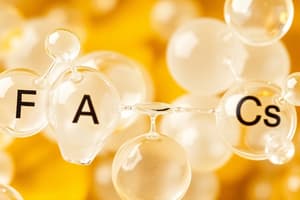Podcast
Questions and Answers
What characteristic makes lipids hydrophobic?
What characteristic makes lipids hydrophobic?
- Presence of polar solvents
- Presence of Hydrocarbon chains (correct)
- High solubility in water
- Increased acidity levels
Which of the following are classified as simple lipids?
Which of the following are classified as simple lipids?
- Gangliosides
- Phospholipids
- Waxes (correct)
- Triglycerides (correct)
What form of energy do lipids primarily provide in the human body?
What form of energy do lipids primarily provide in the human body?
- Structural support
- Thermal energy
- Immediate energy
- Stored energy (correct)
Which of the following is NOT a type of lipid mentioned?
Which of the following is NOT a type of lipid mentioned?
Which classification of lipids includes both phospholipids and sphingolipids?
Which classification of lipids includes both phospholipids and sphingolipids?
What is the primary structure that neutral fats consist of?
What is the primary structure that neutral fats consist of?
Which type of fatty acid contains no double bonds?
Which type of fatty acid contains no double bonds?
Which of the following is a function of lipids in the body?
Which of the following is a function of lipids in the body?
What kind of fatty acid is characterized by having one or more double bonds?
What kind of fatty acid is characterized by having one or more double bonds?
Which fatty acid is commonly found in coconut oil and palm oil?
Which fatty acid is commonly found in coconut oil and palm oil?
Which of the following fatty acids is a saturated fatty acid with 18 carbon atoms?
Which of the following fatty acids is a saturated fatty acid with 18 carbon atoms?
Which of the following accurately describes simple neutral fats?
Which of the following accurately describes simple neutral fats?
Which of the following is a characteristic of polyunsaturated fatty acids?
Which of the following is a characteristic of polyunsaturated fatty acids?
Which fatty acid is considered essential and must be obtained through the diet?
Which fatty acid is considered essential and must be obtained through the diet?
In the classification of fatty acids, what does 'omega (ω)' refer to?
In the classification of fatty acids, what does 'omega (ω)' refer to?
Flashcards are hidden until you start studying
Study Notes
Lipids
- Heterogeneous group of organic molecules related to fatty acids
- Relatively insoluble in water (hydrophobic) due to the predominance of hydrocarbon chains
- Soluble in non-polar solvents such as ether, benzene, chloroform, and acetone
- Most efficient form of stored energy in humans
- Form a major part of our diet alongside carbohydrates and proteins
- Excess lipids are stored as fat
- Examples: Fatty acids, tri-acylglycerol, phospholipids, glycolipids, sphingolipids, steroids, vitamins A, D, E and K
Classification of Lipids
- Simple:
- Neutral fats:
- Esters of fatty acids with glycerol
- Neutral (carry no charge)
- Types:
- Fats (Acylglycerol): Esters of fatty acids with glycerol (e.g., triglycerides)
- Waxes: Esters of fatty acids with higher alcohols (alcohols other than glycerol, e.g., beeswax, lanolin)
- Neutral fats:
- Conjugated (Complex):
- Esters of fatty acids with alcohol, in addition to other groups (e.g., phospholipids)
- Phospholipids:
- Glycerophospholipids
- Sphingophospholipids
- Sphingolipids:
- With or without phosphate:
- Glycolipids
- Sulfolipids
- Gangliosides
- Mucolipids
- With or without phosphate:
- Proteolipids (Lipoproteins):
- Derived:
- Any substance that can be obtained by hydrolysis of simple or complex lipids (e.g., fatty acids, steroids, fat-soluble vitamins, ketone bodies, carotenoids)
BioMedical Importance of Lipids
- Diet:
- Source of high energy
- Contain fat-soluble vitamins
- Contain essential fatty acids
- Make diet palatable
- Body:
- Adipose tissue: Storage form of energy
- Thermal insulator: Subcutaneous tissue
- Electrical insulator: Nervous tissue (allows rapid propagation)
- Lipoprotein formation:
- Component of cell membrane structure
- Act as a transport form of energy in the blood
Neutral Fats (Tri Acyl Glycerol)
- Esters of 3 fatty acids with glycerol
- Glycerol: Short-chain alcohol containing 3 OH groups
- Types:
- Simple: Contains similar fatty acids (e.g., tripalmitin and triolein)
- Mixed: Contains different fatty acids (e.g., palmito-oleio-stearin and di-stearin palmitin)
- Solid form: Fats
- Liquid form: Oils
Fatty Acids (FA)
- Long-chain organic molecules containing carboxylic end (COOH)
- Types:
- Saturated:
- No double bonds (no C=C)
- Non-essential
- Unsaturated:
- Contain one or more double bonds
- Essential or non-essential
- Saturated:
- Water insoluble long-chain hydrocarbons
- Can be saturated or unsaturated
- Mostly mono-carboxylic acids
- Mostly aliphatic (no-branches) acids
- Occur mainly as esters in neutral fats
- Can occur freely in plasma
- Fatty acids in neutral fats contain an even number of carbons
Saturated Fatty Acids (Anoic)
- No double bonds (no C=C)
- General Formula: CH3 - (CH2)n- COOH
- (n): number of methylene groups (CH2 )
- Examples:
- Butyric acid (4C): CH3 – CH2 – CH2 – COOH
- Caproic acid (6C): CH3– (CH2)4– COOH
- Palmitic acid (16C): CH3 – (CH2)14– COOH
- Stearic acid (18C ): CH3 – (CH2)16– COOH
Carbon Skeleton of Fatty Acid
- Numbered either:
- From the Carboxylic Group (COOH):
- Delta (Δ) or Alpha, Beta, Gamma, Delta, Epsilon
- From the Terminal Methyl Group (Omega=ώ):
- From the Carboxylic Group (COOH):
Non-Essential Fatty Acids
- Can be synthesized in the body from Acetyl CoA (common metabolic pool)
- Include saturated & mono-unsaturated FA
Unsaturated Fatty Acids (Enoic)
- Fatty acids containing double bond(s)
- Types:
- Mono-unsaturated: One double bond
- Poly-unsaturated: More than one double bond
- General Formula: Cn – H2n-1– COOH
- (n): number of carbon atoms without COOH
- Double bonds:
- Nearly always in cis configuration
- Spaced at 3 carbon intervals if the fatty acid has more than one double bond
Mono-unsaturated Fatty Acids
- MonoEnoic Fatty acids (Non-essential):
- Example:
- Palmitoleic (16C) written as 16:1 Δ9, 16:1 ώ7
- Oleic = OctaDecaEnoic (18C) written as 18:1 Δ9
- Example:
Poly-unsaturated Fatty Acids
- PolyEnoic fatty acids (Essential):
- Linoleic acid (18:2 Δ9,12 )
- Linolenic acid (18:3 Δ9,12,15 )
- Arachidonic acid (20:4 Δ5,8,11,14)
- PolyThenoic fatty acids:
- Docosahexaenoic acid (DHA) (22:6 ω3 )
- Eicosapentaenoic acid (EPA) (20:5 ω3)
Essential Fatty acids
- Cannot be synthesized in the body
- Must be obtained from the diet
- Play essential roles in cell membrane function, hormone synthesis, and inflammatory responses
Naming of Fatty Acids
- Delta (Δ) system: Begins at carboxyl group
- Omega (ώ) system: Begins at methyl group
- Common names: Based on the number of carbons, level of saturation, and location of double bonds
Trans Fatty Acids
- Similar to saturated fatty acids in structure
- Increase risk of cardiovascular disease
Essential Fatty Acids
- Linoleic acid (C18:2 ω6): precursor to arachidonic acid
- α-Linolenic acid (C18:3 ω3): precursors to EPA and DHA
Importance of Essential Fatty Acids
- Role in growth and development
- Immune function
- Regulation of blood pressure and cholesterol levels
- Brain function
- Inflammation and pain control
Studying That Suits You
Use AI to generate personalized quizzes and flashcards to suit your learning preferences.




